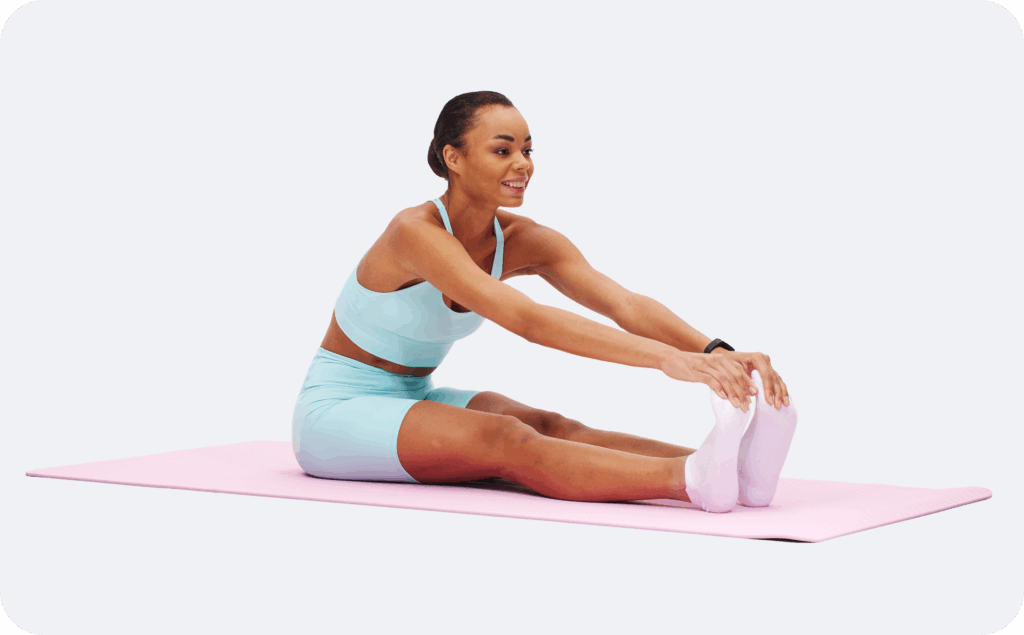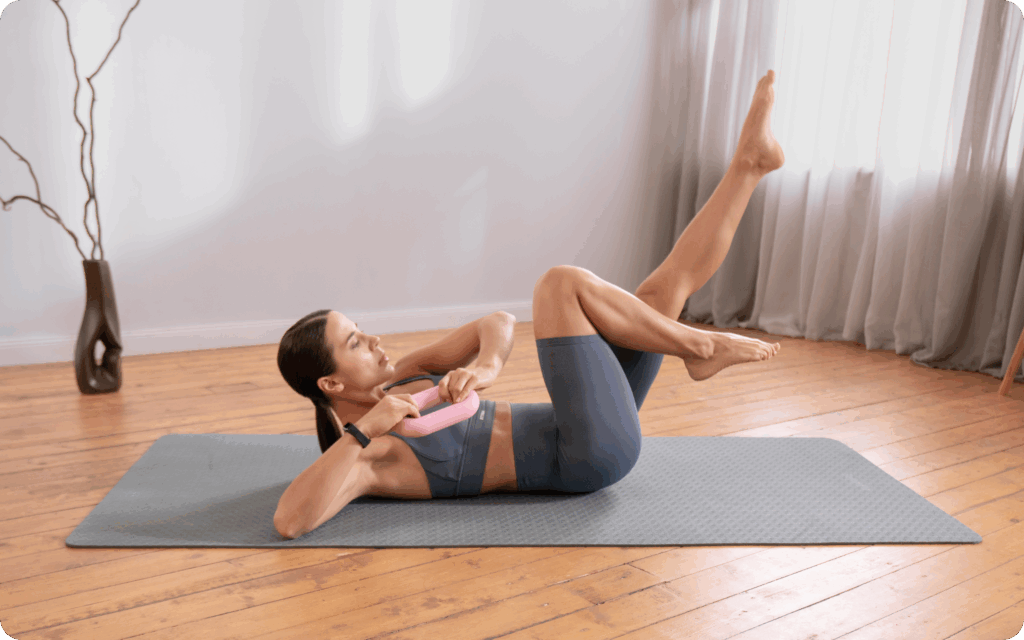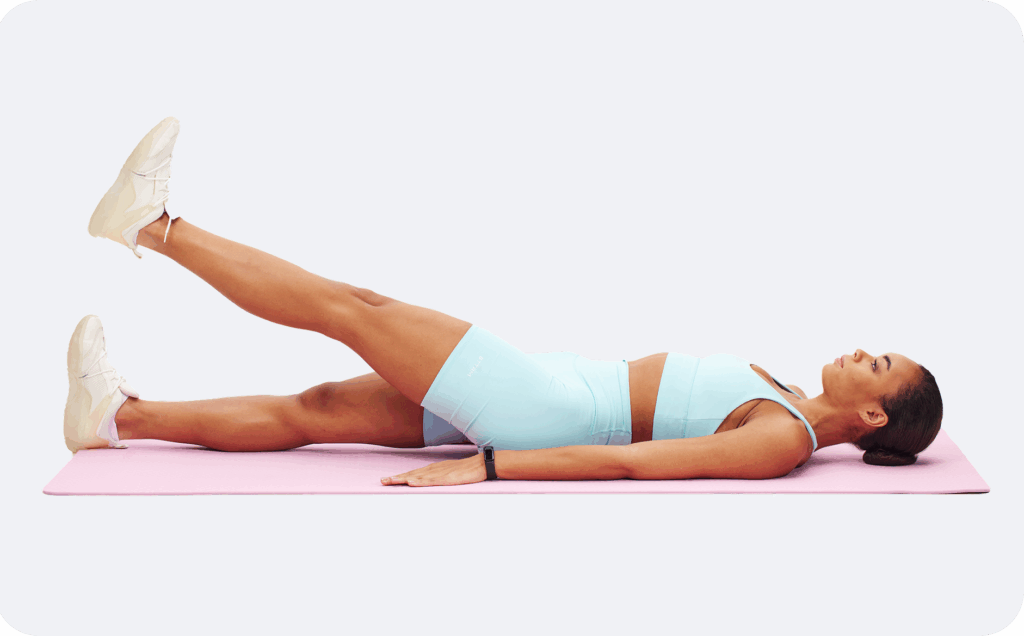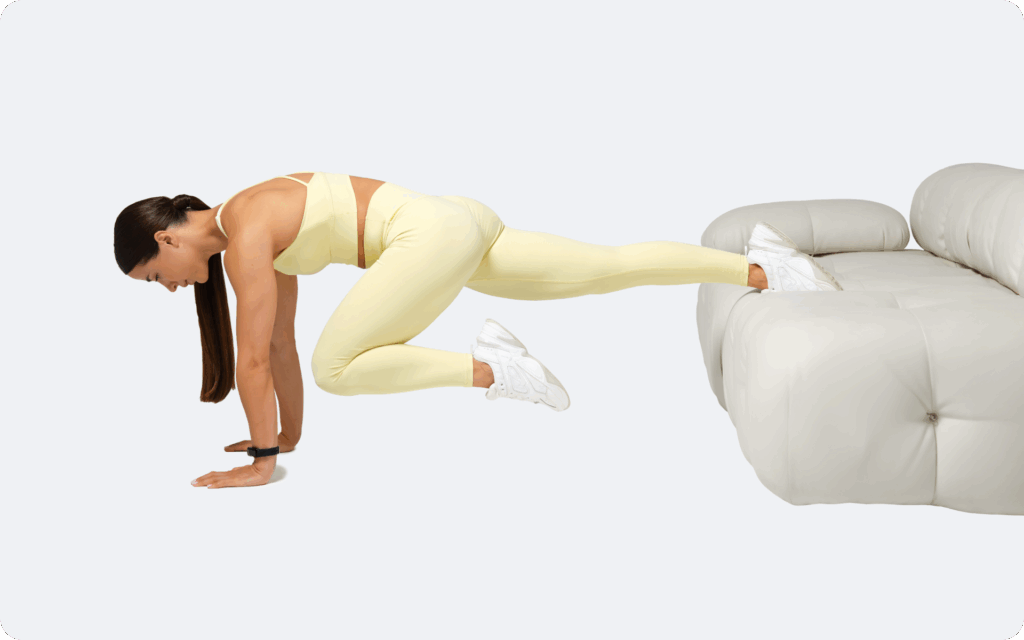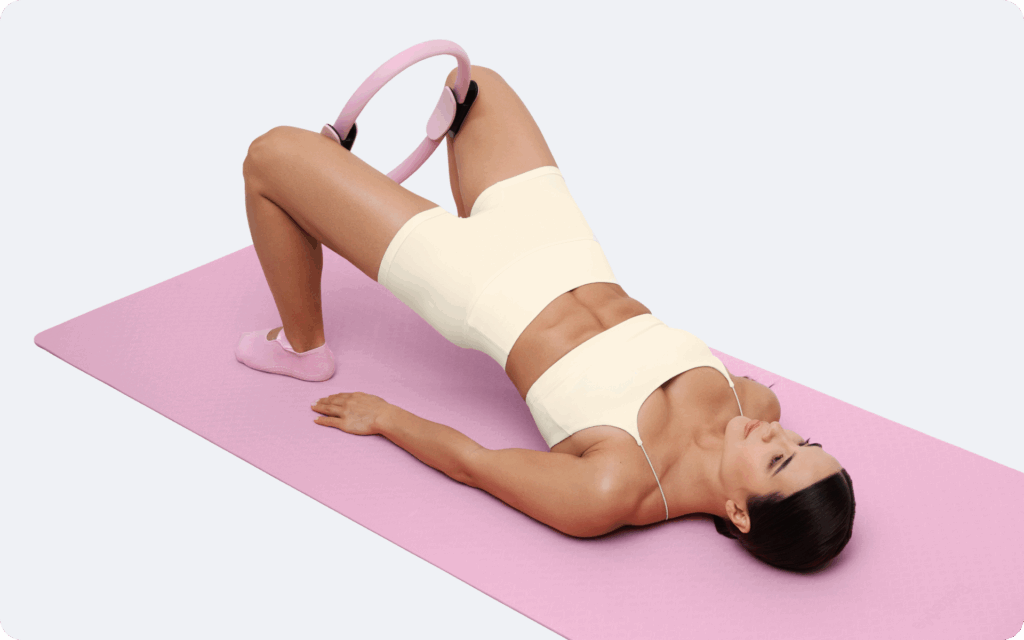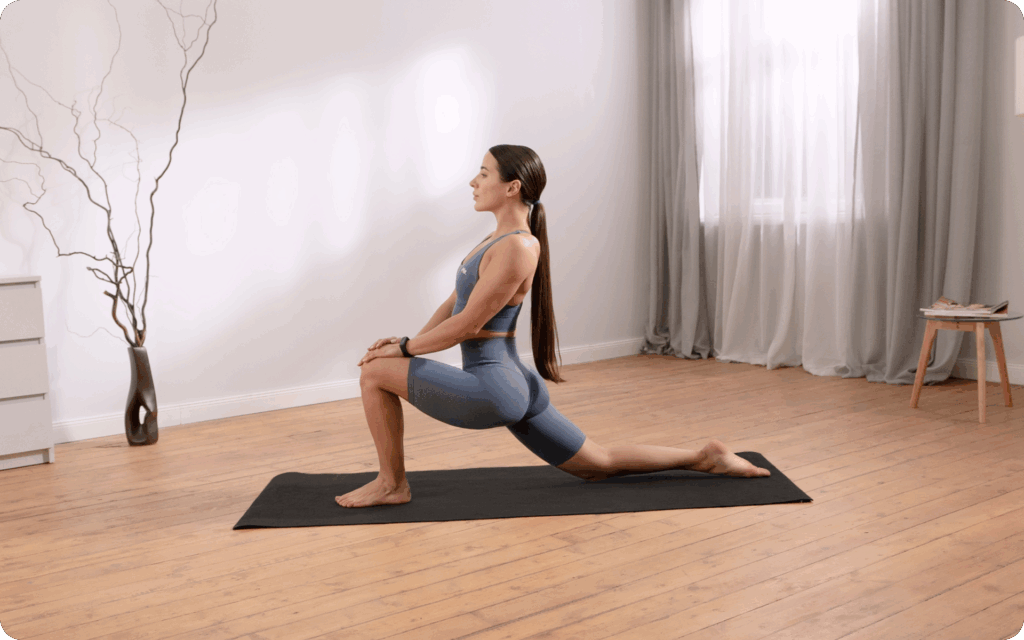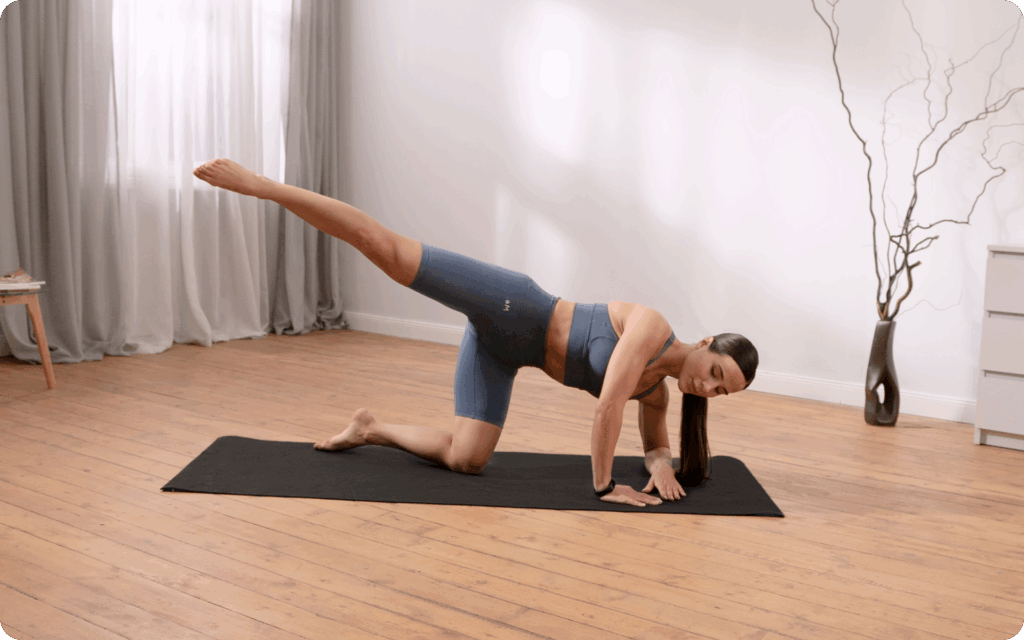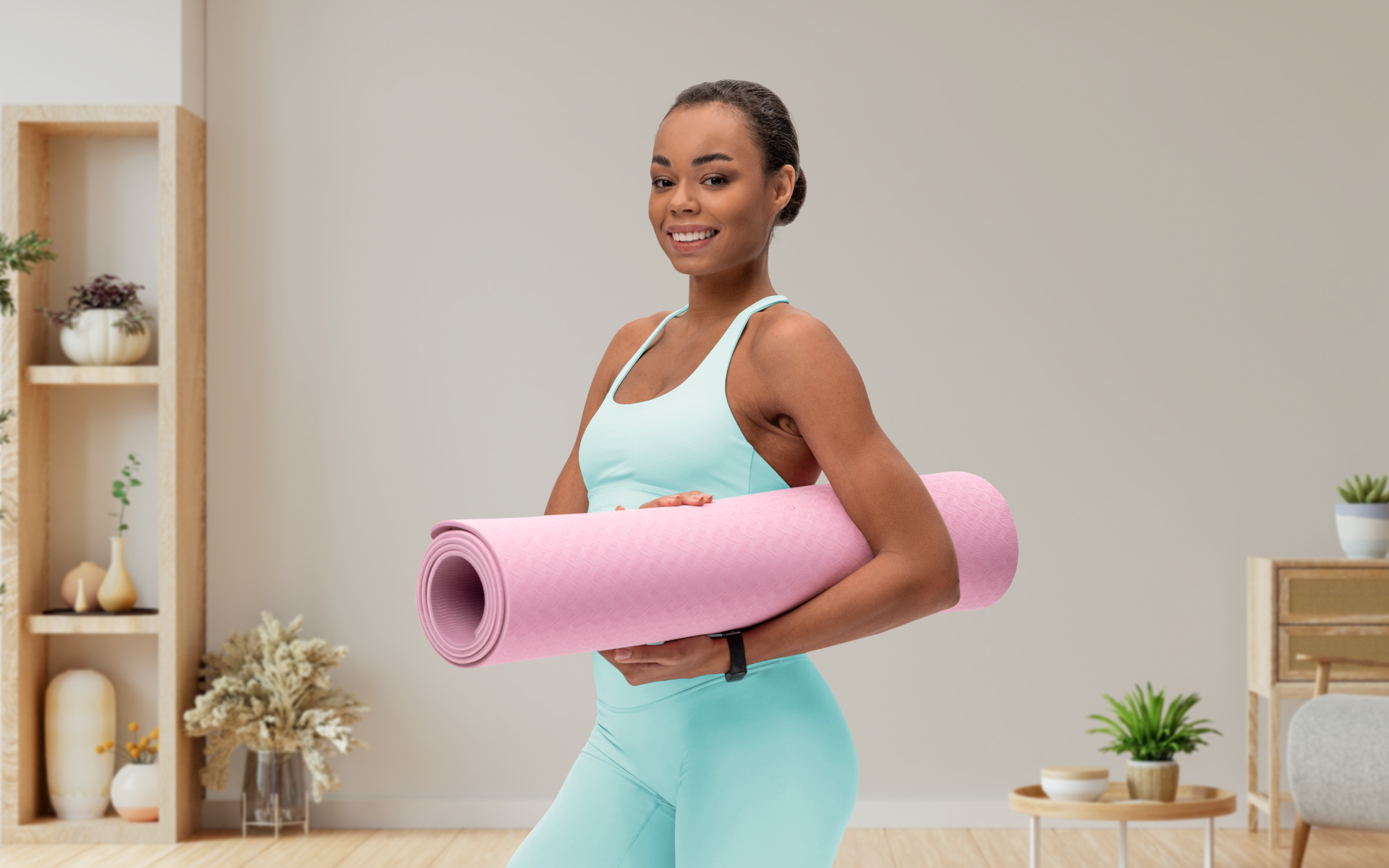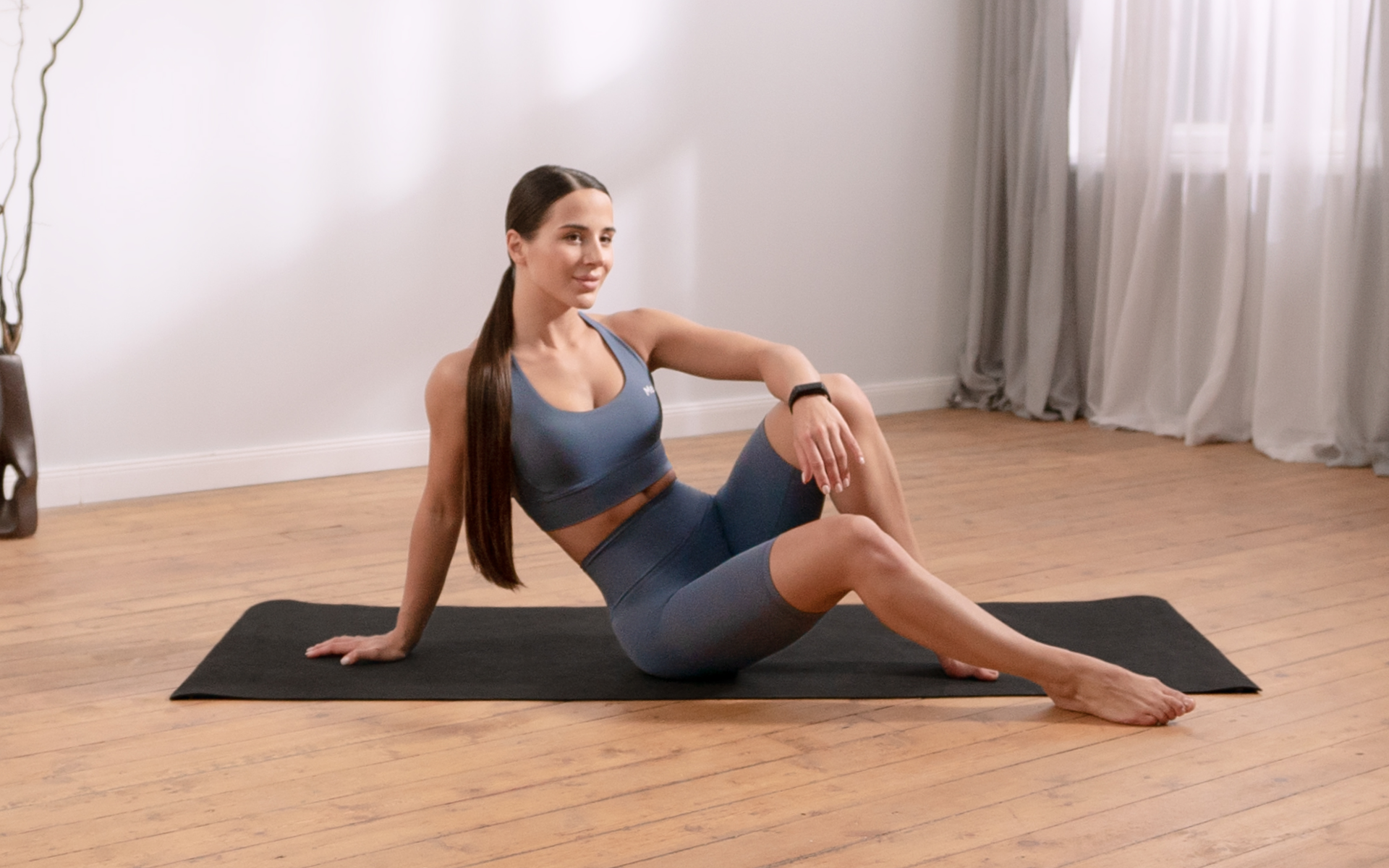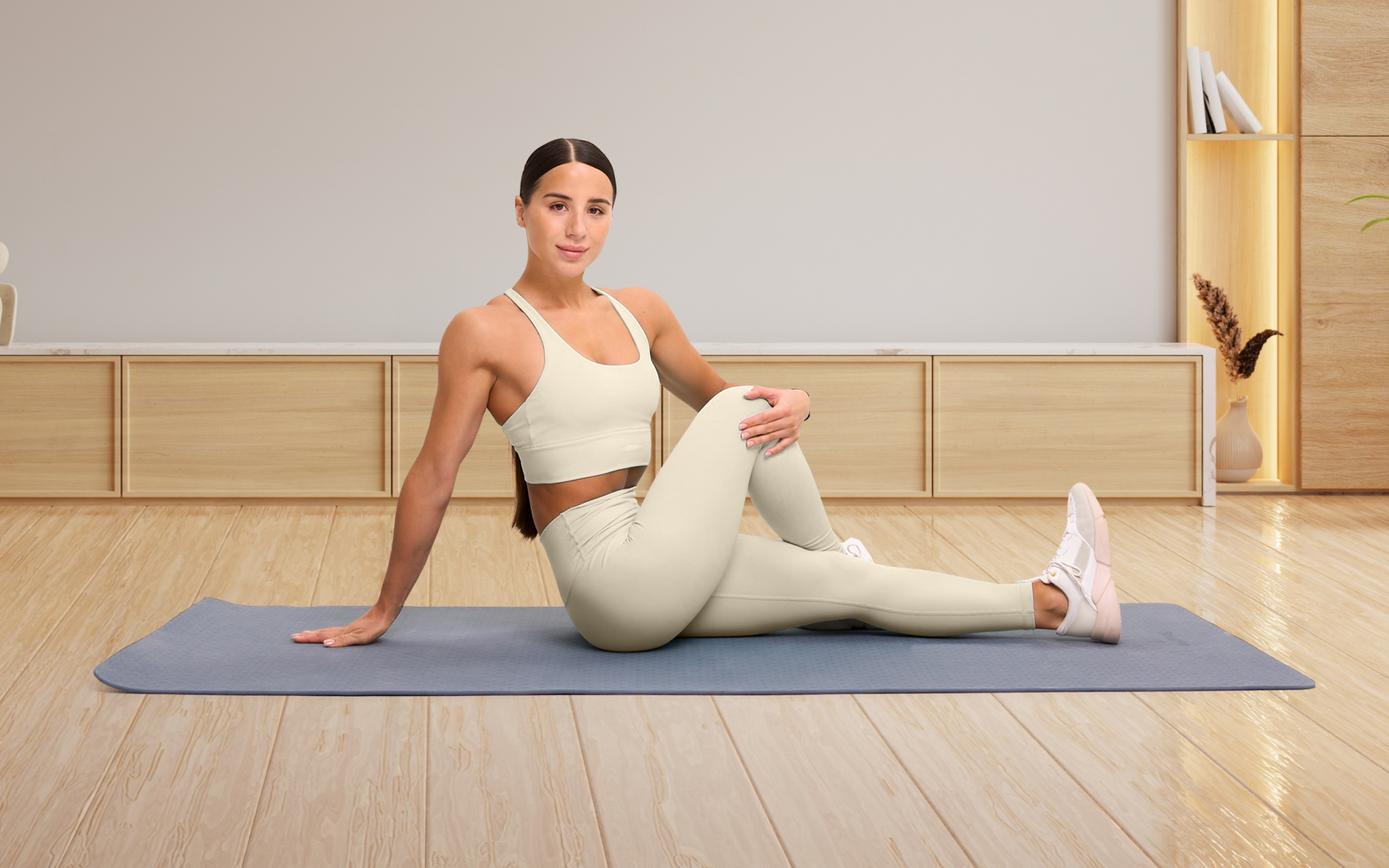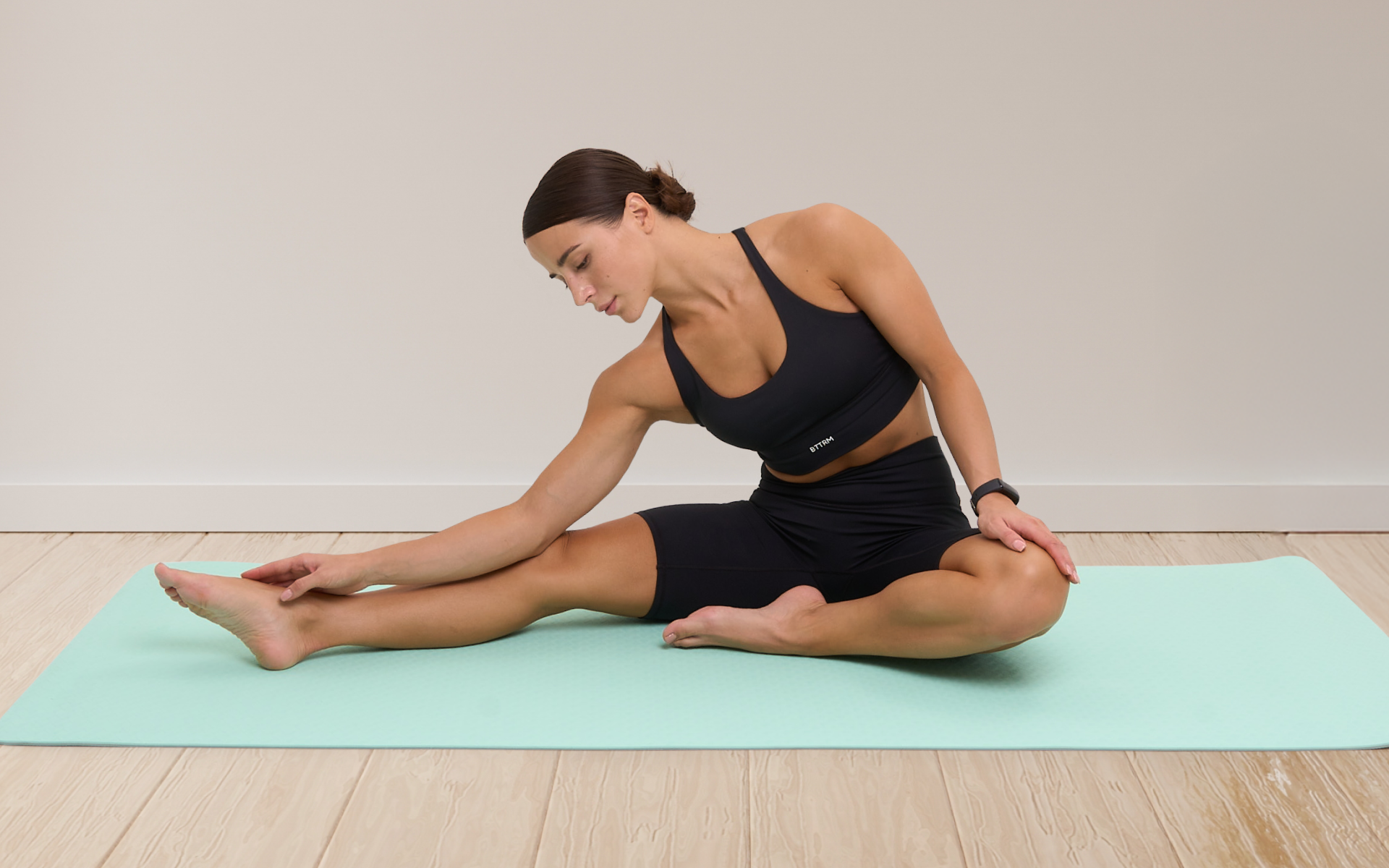Whoever said that Pilates is not as powerful as the machine alternatives? On the contrary, this activity engages your core, glutes, and legs just as efficiently as exercises performed on the reformer or other equipment. No, you don’t need a complex Reformer Pilates mat exercises list to get the results you want.
Consistency and attention to the proper technique can help you reap all the benefits possible: reduce back pain, improve posture, promote flexibility and mobility, and more.
These days, many people like working out from home because it saves both time and money compared to commuting to live classes.
Mat-based Pilates is a suitable option for beginners and can be done anywhere you like. Don’t forget that Pilates offers a wide range of exercises that are easily adaptable to all fitness levels.
The following Pilates mat exercises list for beginners helps you adjust to the foundational movements gradually. Note: this Pilates practice emphasizes slow, controlled motions, proper breathing, and body alignment rather than performing as many repetitions as possible.
All it takes is a mat, well-chosen movements, and some dedicated time to enhance your physique. Check out the ultimate Pilates mat exercises list and do your core a real favor.
Without further ado, let’s dive into the killer Pilates mat exercises.
Can Pilates Mat Exercises Improve Your Core Strength?
Yes, Pilates mat exercises significantly improve core strength. In fact, this practice specifically fixates on building core strength (1). Pilates floor mat exercises, unlike traditional workouts, emphasize the simultaneous engagement of multiple muscle groups, with a particular focus on the core.
Core in Pilates does not only involve the abdominal muscles, but also the lower back, hips, and pelvic floor. Mat-based exercises encourage controlled movements, proper alignment, and mindful breathing. All Pilates mat exercises engage the stabilizing muscles that are often overlooked during other forms of exercise. If you’re curious about the best pelvic floor exercises, check out our earlier article.
Several studies confirm the efficacy of Pilates in activating the core and improving strength. For example, a 2023 systematic review suggests that Pilates can help you strengthen your core and relieve lower back pain (2).
Another 2024 study in Frontiers showed that Pilates practice activates your core to a great level (3).
A 2022 study found that core-focused Pilates moves improved strength and overall well-being in teens experiencing knee pain (4).
That said, performing Pilates regularly helps strengthen and tone core muscles, improving stability, balance, and posture. This improvement can reduce the risk of back pain and injuries by enhancing spinal support.
Slow-paced movements teach body awareness and control, which helps you develop a stronger, more resilient core.
Read more: Body Transformation With Pilates: What Really Happens When You Stay Consistent
What Is A Strengthening Pilates Mat Exercises List?
This full-body pilates mat exercises list features 13 movements designed to strengthen your body while improving flexibility. Suitable for beginners and intermediate practitioners, the following exercises require only a mat, your free time, and the desire to train.
- The Hundred
- Roll-Ups
- Single-Leg Stretch
- The Double Leg Stretch
- Criss-Cross
- Leg Circles
- Plank Leg Lift
- Bird Dog
- Slow-Paced Mountain Climber
- Bear Plank with Toe Taps to Downward Dog
- Glute Bridges with Arm Reach
- Bear Plank with Donkey Kick
- Forearm-supported Lean Back with Double Toe Tap
BetterMe: Health Coaching app helps you achieve your body goals with ease and efficiency by helping to choose proper meal plans and effective workouts. Start using our app and you will see good results in a short time.
The Hundred
How you do it:
- Lie on your back with your knees bent in a tabletop position and your arms by your sides.
- Lift your head, neck, and shoulders off the mat. Extend your legs to a 45-degree angle.
- Pump your arms up and down while inhaling for 5 counts and exhaling for 5 counts.
- Repeat this breathing pattern 10 times while holding this position.
Roll-Ups
How you do it:
- Lie flat on your back with your legs extended and arms overhead.
- Inhale while raising your arms toward the ceiling. Slowly exhale while curling your body up until you’re sitting and reaching for your toes.
- Breathe in again, exhale, and slowly roll back down to the mat.
- Move slowly and smoothly, keeping your core engaged throughout the movement.
- Repeat 5-8 times.
Single-Leg Stretch
How you do it:
- Lie on your back with your knees on the tabletop. Lift your shoulders and head off the mat.
- Draw your right knee toward your chest while extending the left leg out. Place your right hand on your ankle, and your left hand on your knee.
- Alternate legs in the slow, controlled motion.
- Keep your lower back on the floor during the entire exercise.
The Double Leg Stretch
How you do it:
- Lie face up and hug both knees to your chest. Curl your head up and place your hands on your knees.
- Inhale as you extend your arms overhead and legs out at a 45-degree angle. Keep your lower back on the floor.
- Exhale as you circle your arms out and around back to your knees, as you draw your knees back in toward your chest.
- Repeat 7-9 times.
Criss-Cross
How you do it:
- Lie on your back with your hands behind your head and knees lifted.
- Lift your head and shoulders, then bring your right elbow to your left knee as you extend your right leg out.
- Switch sides, twisting your torso and engaging your obliques.
- Continue alternating in the bicycle-like motion.
Leg Circles
How you do it:
- Lie on your back with your arms by your sides.
- Extend your left leg toward the ceiling and keep your right leg long on the mat.
- Inhale and then exhale as you circle the raised leg across your body, down, and around to the starting point.
- Avoid moving your hips. Perform 5-8 circles in each direction and switch legs.
Plank Leg Lift
How you do it:
- Get into a high plank position with your wrists under your shoulders and body in one straight line.
- Engage your core and the right foot off the mat without arching your back or twisting your hips.
- Lower the leg slowly and repeat on the other side.
- Alternate for 8-10 repetitions per leg.
Bird Dog
How you do it:
- Start on all fours with your wrists stacked under your shoulders and your knees under your hips.
- Keep your spine neutral. Extend the right arm forward and the left leg back. Hold for a breath, squeeze your abs, and return your arm and leg to the starting position. This movement is one rep.
- Do 8 repetitions on one side, then the next 8 on the other.
Slow-Paced Mountain Climber
How you do it:
- Start in a high plank position with your hands directly under your shoulders.
- Bring one knee toward your chest, keep your butt and core engaged to avoid rocking your hips.
- Then bring the other leg and slowly alternate legs.
Bear Plank With Toe Taps To Downward Dog
How you do it:
- Start in a bear plank by placing your hands under your shoulders; keep your knees bent, and hover just off the mat.
- Engage your core and lift your hips up and back into a Downward Dog position by slowly lifting your knees off the mat and straightening your legs.
- Then get back to the bear plank position and tap your right foot to the side, then the left foot to the side.
- Continue alternating for 8-10 reps.
Glute Bridges with Arm Reach
How you do it:
- Lie on your back with your knees bent and feet hip-width apart.
- Engage your core, press your heels to lift your hips off the mat into a bridge.
- As you lift, extend your arms overhead.
- Lower your arms as you roll your spine back down to the mat.
- Repeat 12 times.
Bear Plank with Donkey Kick
How you do it:
- Get into a bear plank position with your hands stacked under your shoulders and knees hovering.
- Engage your abs to lift your right heel toward the ceiling in a controlled kick; keep your knee bent.
- Lower the knee back and repeat on the other side. Squeeze your glutes.
- Repeat 5 times on each leg.
Forearm-supported Lean Back with Double Toe Tap
How you do it:
- Sit with your knees bent, feet flat, and forearms resting on the mat behind you.
- Engage your abs and lift both feet off the mat into a tabletop position.
- Slowly tap both toes to the mat, then lift them, keeping your core tight.
- Repeat 9-10 times.
You can follow a classical Pilates mat sequence at your own pace.
If any move feels too difficult to perform, don’t push yourself to do it. Perform easier exercises, so-called beginner-friendly options, and shift to a more difficult version as your strength improves.
Read more: Pilates Progress: Effective Ways To Measure Pilates Workout Success
What Are The Most Essential Pilates Mat Exercises?
All 13 exercises mentioned above are essential in developing a stronger, more stable core. Your body will be grateful.
Yet, sometimes you may not have enough time or energy for all 13 moves.
Therefore, if you’re working on the Pilates foundation with little time availability, start with these 7 core exercises:
- The Hundred
- Single Leg Stretch
- Double-Leg Stretch
- Bird Dog
- Leg Circles
- Glute Bridges with Arm Reach
- Slow-Paced Mountain Climber
The following foundational movements build stability, core strength, and flexibility safely.
As you master these, you’ll shift to more dynamic moves like Criss-Cross or Plank Leg Lifts.
Can Beginners Follow A Pilates Mat Exercises List At Home?
Absolutely, anyone, regardless of their fitness level, can follow mat Pilates exercises at home. Mat Pilates is adaptable, making it perfect for newbies.
The practice requires minimal equipment (in your case, a mat), focusing purely on controlled, low-impact movements that strengthen your core.
As you practice Pilates from home, here are a few tips for you:
- Start with simpler exercises. Try not to perform all 13 Pilates exercises for beginners at once. Create a sequence that includes up to 7 exercises.
- Prioritize form and proper technique over repetitions. Move slowly, with control; don’t forget to breathe well, and you’ll be fine.
- Modify moves if necessary. Make the move easier by bending your knees, doing fewer repetitions, and taking short breaks before trying it again.
- Do Pilates consistently for at least 10-15 minutes a day. You’re not obliged to train daily – 3 to 4 times a week is enough for beginners.
- Pay attention to how your body reacts to each move. Stop the exercise if you feel pain or discomfort.
Mat Pilates is a safe and easy practice to start with. Basic moves can help your body gain strength and flexibility for much more challenging exercises.
Reasons why BetterMe is a safe bet: a wide range of calorie-blasting workouts, finger-licking recipes, 24/7 support, challenges that’ll keep you on your best game, and that just scratches the surface! Start using our app and watch the magic happen.
How Can A Pilates Mat Exercises List Be Adapted For Different Fitness Levels?
It’s easy to adapt Pilates to different fitness levels.
- Let’s start with beginners: if you’re a beginner, your Pilates exercises can be simplified by reducing the range of motion, bending the knees, keeping the head on the mat, or performing fewer repetitions.
- Intermediate and more advanced practitioners can increase the intensity by adding pulses, performing more repetitions, holding positions longer, and incorporating small props, such as resistance bands or a foam roller.
- Starting with simpler moves and ending the training with demanding ones can help trainees build strength and control. This Pilates routine becomes enjoyable, safe, and effective for all athletic abilities.
What Common Mistakes Should You Avoid In A Mat Pilates Routine?
Even though Pilates looks graceful and effortless, it’s possible to mess it up with poor form or fast-paced moves. What are common mistakes to avoid during Pilates?
One of the biggest mistakes is rushing through the movements.
The thing is, Pilates is all about control, where slow, deliberate motions fire up deep core muscles. Another slip-up is holding your breath; instead, inhale to lengthen and exhale to power your movement.
Another mistake people frequently make is forgetting about body alignment; keep your spine neutral, shoulders relaxed, and hips steady. Steer clear of arching your back or tensing your neck, as it steals the work from your core.
Beginners should skip more challenging modifications or difficult moves as they start Pilates from home. It’s fine to begin with easier movements, let your body adjust, and move on to more challenging ones.
And the last tip for this section: Lean towards quality over quantity.
5 mindful repetitions are better than 15 rushed ones.
Breathe well, focus on each move, and flow. It’s your powerful way to build core strength and confidence to perform advanced moves.
A mat Pilates training session does not need to be long, as 20 minutes is enough for beginners to strengthen their core and boost flexibility. Not at all. If you’re starting Pilates, the only equipment you need is a mat. You can perform many exercises without other equipment. As your strength and stability improve, you can add other props, such as resistance bands or a foam roller, to further enhance your workout. To build strength and flexibility, experts recommend practicing Pilates consistently at least three times a week. Be sure to add in regular rest days to allow your body to recover. Even short exercises can deliver noticeable results, helping you feel more balanced and energized. Pilates exercises sculpt long, lean muscles while gently enhancing overall flexibility. A 2021 study on middle-aged sedentary women found that Pilates can effectively improve flexibility when compared to a group who did no exercise at all (5).Frequently Asked Questions
How long should a pilates mat workout take?
Do I need special equipment for pilates mat exercises?
How often should I do pilates mat exercises?
Are pilates mat exercises good for flexibility?
The Bottom Line
You’ve unlocked the ultimate Pilates mat exercises list and are ready to do your core a real favor. Pilates is the fusion of strength, flexibility, and mindful movement that tones your muscles.
These 13 core-strengthening Pilates moves are perfectly tailored for beginners and intermediate practitioners seeking home-based workouts. Newbies, though, shouldn’t necessarily nail all the movements in one session; instead, they may start with 7 Pilates basics, nurturing physical strength, flexibility, and inner calm.
If you’re just starting out, 3, 20-minute Pilates sessions a week are all you need to tone, stretch, and feel stronger.
DISCLAIMER:
This article is intended for general informational purposes only and does not serve to address individual circumstances. It is not a substitute for professional advice or help and should not be relied on for making any kind of decision-making. Any action taken as a direct or indirect result of the information in this article is entirely at your own risk and is your sole responsibility.
BetterMe, its content staff, and its medical advisors accept no responsibility for inaccuracies, errors, misstatements, inconsistencies, or omissions and specifically disclaim any liability, loss or risk, personal, professional or otherwise, which may be incurred as a consequence, directly or indirectly, of the use and/or application of any content.
You should always seek the advice of your physician or other qualified health provider with any questions you may have regarding a medical condition or your specific situation. Never disregard professional medical advice or delay seeking it because of BetterMe content. If you suspect or think you may have a medical emergency, call your doctor.
SOURCES:
- Pilates 101: What It Is and Health Benefits (2023, health.clevelandclinic.org)
- Pilates to Improve Core Muscle Activation in Chronic Low Back Pain: A Systematic Review (2023, pmc.ncbi.nlm.nih.gov)
- Comparisons of functional movements and core muscle activity in women according to Pilates proficiency (2024, frontiersin.org)
- Incorporation of Pilates-based core strengthening exercises into the rehabilitation protocol for adolescents with patellofemoral pain syndrome: a randomized clinical trial (2022, europeanreview.org)
- The Effects of Pilates Mat Exercises on self-rated health Levels, Body Mass Index and Flexibility in Middle Age Sedentary Women (2021, researchgate.net)


